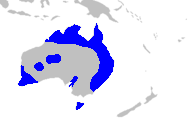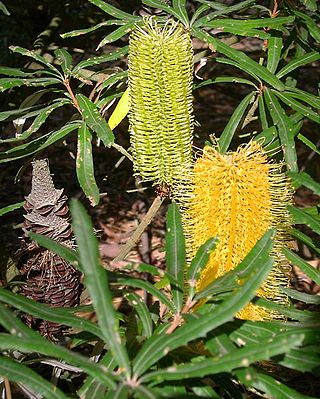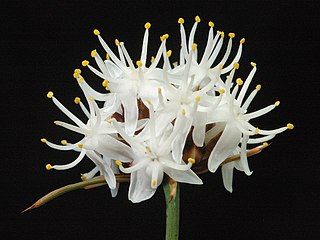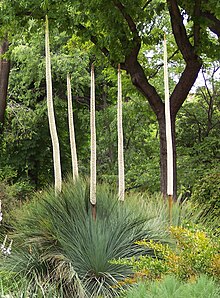
Xanthorrhoea is a genus of about 30 species of succulent flowering plants in the family Asphodelaceae. They are endemic to Australia. Common names for the plants include grasstree, grass gum-tree, kangaroo tail, balga, yakka, yamina (Tasmania), and black boy. The most common species is Xanthorrhoea australis, and some of these names are applied specifically to this species.

Kingia is a genus consisting of a single species, Kingia australis, and belongs to the plant family Dasypogonaceae. The Aboriginal name bullanock is used as a common name for the plant. It has a thick pseudo-trunk consisting of accumulated leaf-bases, with a cluster of long, slender leaves on top. The trunk is usually unbranched, but can branch if the growing tip is damaged. Flowers occur in egg-shaped clusters on the ends of up to 100 long curved stems. Kingia grows extremely slowly, the trunk increasing in height by about 1½ centimetres per year. It can live for centuries, however, so can attain a substantial height; 400-year-old plants with a height of six metres are not unusual.

Prasophyllum, commonly known as leek orchids, is a genus of about 140 species of flowering plants in the orchid family, Orchidaceae and is found in Australia and New Zealand. The Australian species are found in all states but have not been recorded in the Northern Territory. The common name arises from their having a hollow, leek- or onion-like leaf. Some species only flower after summer fires and have flowers similar to those of Xanthorrhoea which flower at the same time, suggesting that they employ the same pollinating insects. Leek orchids are similar to those in the genus Genoplesium except that the free part of the leaf is cylindrical and the labellum has a solid connection to the column. They range in size from the little laughing leek orchid at about 15 cm (6 in) to the king leek orchid which grows up to 2 m (80 in) tall.

Banksia seminuda, commonly known as the river banksia, is a tree in the family Proteaceae. It is found in southwest Western Australia from Dwellingup (32°42′ S) to the Broke Inlet east of Denmark (34°57′ S). It is often mistaken for, and was originally considered a subspecies of, the Banksia littoralis. Stephen Hopper described the subspecies remanens as a short-leaved shrubby form found in the coastal sands below granite outcrops in the Walpole-Nornalup National Park. However, George does not feel this form warrants taxonomic recognition as it lies within the normal variability of the species and there was no clear distinction between it and the other populations of B. seminuda.

Xanthorrhoea australis, the grass tree or austral grasstree, is an Australian plant. It is the most commonly seen species of the genus Xanthorrhoea. Its trunk can grow up to several metres tall and is often branched. In certain Aboriginal languages, it is called bukkup, baggup or kawee.

Frankenia pauciflora, the common sea-heath or southern sea-heath, is an evergreen shrub native to southern Australia. It is part of the Frankenia genus of the Frankeniaceae family.

Xanthorrhoea preissii, known as balga, is a widespread species of perennial monocot in Southwest Australia.

Acacia gunnii, commonly known as ploughshare wattle or dog's tooth wattle, is a woody shrub which is endemic to south-eastern Australia found in dry heaths and woodlands. It ranges from Queensland, then New South Wales, Australian Capital Territory, Victoria, South Australia, down to Tasmania. Acacia gunnii grows to up to 1 metre high and has prickly phyllodes which are 4 to 15 mm long. The cream to pale yellow globular flowerheads appear singly in the axils of the phyllodes in June to October, followed by curved or coiled seed pods which are 40 mm long and 4 to 5 mm wide. Acacia gunnii grows up to 1 meter tall and has prickly phyllodes which are 4 to 15mm in length with cream to pale-yellow globular flower heads appearing in phyllode axils in June through to October, followed by curved or coiled seed pods which are 40mm long and 4 to 5 mm wide. The species was first formally described by English botanist George Bentham in the London Journal of Botany in 1842. It occurs in South Australia, Victoria, Tasmania, New South Wales, Australian Capital Territory, and Queensland.

Xanthorrhoea glauca, known as the black boy or grass tree, is a large plant in the genus Xanthorrhoea, widespread in eastern Australia. The trunk can grow in excess of 5 metres tall, and may have many branches. It is occasionally seen in large communities in nutrient rich soils. The leaves are a grey or bluish glaucous green.

Xanthorrhoea semiplana is a species of grass tree found in south-eastern Australia, with two subspecies:

Gonocarpus tetragynus is an Australian herb in the watermilfoil family Haloragaceae native to eastern Australia. Common names include common raspwort. A widespread species particularly found in dry eucalyptus forests, scrubland, and heathland.

Persoonia terminalis, also known as the Torrington geebung, is a shrub belonging to the family Proteaceae, and native to northern New South Wales and southern Queensland in eastern Australia. Reported as a subspecies of Persoonia nutans in 1981, it was described as a species by Lawrie Johnson and his colleague Peter Weston in 1991.

Lomandra effusa is a perennial, dioecious, rhizomatous herb native to Australia. It is a perennial tussock with bluish green, large, arching leaves which are distinctive by the two toothed leaf tip. It has white, cream or pink fragrant flowers during the months of June to October.
Xanthorrhoea brevistyla is a species of grasstree of the genus Xanthorrhoea native to Western Australia.

Xanthorrhoea brunonis is a species of grasstree of the genus Xanthorrhoea native to Western Australia.

Xanthorrhoea gracilis, commonly known as the graceful grasstree, grassboy or mimidi, is a species of grasstree of the genus Xanthorrhoea native to Western Australia.

Xanthorrhoea thorntonii, commonly known as Cundeelee grasstree, Cundeelee blackboy, desert grasstree, yacka or grasstree, is a species of grasstree of the genus Xanthorrhoea native to central Australia. It is known to the Pitjantjatjara people as kata-kultu, kata-puru, ulpa or urara, the Warlpiri people as yurlurnkuru and the Arrernte as lunkere. X. thorntonii is the only grass tree found in Central Australia including the Great Sandy Desert, Great Victoria Desert and MacDonnell Ranges.

Isotoma petraea, commonly known as rock isotome, is a small, herbaceous plant in the family Campanulaceae occurring in arid regions of Australia. It has single, purplish-blue flowers on smooth, slender branches from February to November.

Stackhousia clementii is a species of plant in the family Celastraceae and is native to Australia.

Borya sphaerocephala is a perennial herbaceous plant found in southwest Australia. A common name for the species is pincushions. The height is 20–200 millimetres, White flowers appear between August and October. The species is associated with the region's granite outcrops, occurring in depressions and seasonally wet areas, growing in crevices and at the edge of moss mats. As a resurrection plant it is able to withstand seasonal dehydration of its environ. The species was first described by Robert Brown, published in his 1810 work on Australian plants. A combination Baumgartenia sphaerocephala, currently regarded as synonym, was published by Kurt Sprengel several years after Brown.






















